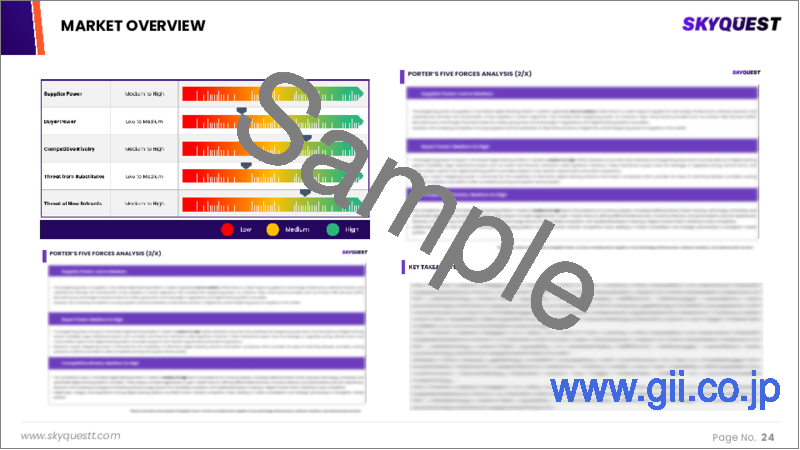|
|
市場調査レポート
商品コード
1670165
振動モニタリング市場規模、シェア、成長分析、提供製品別、監視プロセス別、展開タイプ別、用途別、産業別、地域別 - 産業予測、2025-2032年Vibration Monitoring Market Size, Share, and Growth Analysis, By Offering, By Monitoring Process, By Deployment Type, By Application, By Industry, By Region - Industry Forecast 2025-2032 |
||||||
|
|||||||
| 振動モニタリング市場規模、シェア、成長分析、提供製品別、監視プロセス別、展開タイプ別、用途別、産業別、地域別 - 産業予測、2025-2032年 |
|
出版日: 2025年02月28日
発行: SkyQuest
ページ情報: 英文 199 Pages
納期: 3~5営業日
|
全表示
- 概要
- 目次
振動モニタリングの世界市場規模は2023年に16億米ドルと評価され、2024年の16億9,000万米ドルから2032年には26億1,000万米ドルに成長し、予測期間(2025-2032年)のCAGRは5.6%で成長する見通しです。
世界の振動モニタリング市場は、製造業、エネルギー、石油・ガス、運輸などさまざまな分野の予防保全における状態監視の統合によって、大幅な成長が見込まれています。この技術は、故障の早期発見を可能にし、重要な資産の寿命を延ばしながら、操業の中断とメンテナンスコストを最小限に抑えます。IoTデバイスやスマートセンサーの導入が進んでいるため、リアルタイムでのデータ収集やメンテナンス効率の向上が可能になり、需要がさらに高まっています。さらに、AI主導の分析と機械学習が予測保全に革命をもたらし、コストのかかるダウンタイムを回避し、リソースの使用を最適化するのに役立っています。ファクトリーオートメーションとスマートメンテナンスシステムが拡大するにつれ、新興技術を活用する革新的な企業は、持続可能性と安全性を重視した運用モデルを変革しており、それによって市場の成長と革新が強化されています。
目次
イントロダクション
- 調査の目的
- 調査範囲
- 定義
調査手法
- 情報調達
- 二次と一次データの方法
- 市場規模予測
- 市場の前提条件と制限
エグゼクティブサマリー
- 世界市場の見通し
- 供給と需要の動向分析
- セグメント別機会分析
市場力学と見通し
- 市場概要
- 市場規模
- 市場力学
- 促進要因と機会
- 抑制要因と課題
- ポーターの分析
主な市場の考察
- 重要成功要因
- 競合の程度
- 主な投資機会
- 市場エコシステム
- 市場の魅力指数(2024年)
- PESTEL分析
- マクロ経済指標
- バリューチェーン分析
- 価格分析
- 技術の進歩
振動モニタリング市場規模:提供製品別
- 市場概要
- ハードウェア
- 振動分析装置
- 振動計
- 加速度計
- 近接プローブ
- 速度センサー
- 振動トランスミッター
- その他のハードウェア
- ソフトウェア
- サービス
振動モニタリング市場規模:監視プロセス
- 市場概要
- オンライン振動モニタリング
- ポータブル振動モニタリング
振動モニタリング市場規模:展開タイプ別
- 市場概要
- オンプレミス
- クラウド
振動モニタリング市場規模:用途別
- 市場概要
- モーター
- ポンプ
- チラー
- ファン
- コンプレッサー
- タービン
- ベアリング
- その他の用途
- ギアボックス
- コンベア
振動モニタリング市場規模:業界別
- 市場概要
- 石油・ガス
- 発電
- 鉱業・金属
- 化学薬品
- 自動車
- 航空宇宙
- 食品・飲料
- その他の産業
振動モニタリング市場規模
- 北米
- 米国
- カナダ
- 欧州
- ドイツ
- スペイン
- フランス
- 英国
- イタリア
- その他欧州地域
- アジア太平洋地域
- 中国
- インド
- 日本
- 韓国
- その他アジア太平洋地域
- ラテンアメリカ
- ブラジル
- その他ラテンアメリカ地域
- 中東・アフリカ
- GCC諸国
- 南アフリカ
- その他中東・アフリカ
競合情報
- 上位5社の比較
- 主要企業の市場ポジショニング(2024年)
- 主な市場企業が採用した戦略
- 最近の市場動向
- 企業の市場シェア分析(2024年)
- 主要企業の企業プロファイル
- 企業の詳細
- 製品ポートフォリオ分析
- 企業のセグメント別シェア分析
- 収益の前年比比較(2022-2024)
主要企業プロファイル
- Baker Hughes Company(USA)
- Emerson Electric Co.(USA)
- SKF(Sweden)
- Schaeffler AG(Germany)
- Parker Hannifin Corp(USA)
- Rockwell Automation, Inc.(USA)
- National Instruments Corporation(USA)
- General Electric Corporation(USA)
- Honeywell International Inc.(USA)
- Bruel & Kjaer Sound & Vibration Measurement A/S(Denmark)
- Meggitt PLC(UK)
- Analog Devices Inc.(USA)
- SPM Instrument AB(Sweden)
- STMicroelectronics(Switzerland)
- PCB Piezotronics Inc.(USA)
- Banner Engineering(USA)
- Azima DLI Corporation(USA)
- Data Physics Corporation(USA)
- Teledyne FLIR LLC(USA)
- ALS Limited(Australia)
結論と提言
Global Vibration Monitoring Market size was valued at USD 1.6 billion in 2023 and is poised to grow from USD 1.69 billion in 2024 to USD 2.61 billion by 2032, growing at a CAGR of 5.6% during the forecast period (2025-2032).
The global vibration monitoring market is poised for substantial growth, driven by the integration of condition monitoring in preventive maintenance across various sectors including manufacturing, energy, oil and gas, and transportation. This technology enables early fault detection, minimizing operational disruptions and maintenance costs while extending the lifespan of critical assets. The rising adoption of IoT devices and smart sensors further fuels demand, allowing for real-time data collection and enhanced maintenance efficiency. Additionally, AI-driven analytics and machine learning are revolutionizing predictive maintenance, helping organizations avert costly downtime and optimize resource usage. As factory automation and smart maintenance systems expand, innovative companies leveraging emerging technologies are transforming operational models, emphasizing sustainability and safety, thereby reinforcing market growth and innovation.
Top-down and bottom-up approaches were used to estimate and validate the size of the Global Vibration Monitoring market and to estimate the size of various other dependent submarkets. The research methodology used to estimate the market size includes the following details: The key players in the market were identified through secondary research, and their market shares in the respective regions were determined through primary and secondary research. This entire procedure includes the study of the annual and financial reports of the top market players and extensive interviews for key insights from industry leaders such as CEOs, VPs, directors, and marketing executives. All percentage shares split, and breakdowns were determined using secondary sources and verified through Primary sources. All possible parameters that affect the markets covered in this research study have been accounted for, viewed in extensive detail, verified through primary research, and analyzed to get the final quantitative and qualitative data.
Global Vibration Monitoring Market Segments Analysis
Global Vibration Monitoring Market is segmented by Offering, Monitoring Process, Deployment Type, Application, Industry and region. Based on Offering, the market is segmented into Hardware, Software and Services. Based on Monitoring Process, the market is segmented into Online Vibration Monitoring and Portable Vibration Monitoring. Based on Deployment Type, the market is segmented into On-premises and Cloud. Based on Application, the market is segmented into Motors, Pumps, Chillers, Fans, Compressors, Turbines, Bearings and Other Applications. Based on Industry, the market is segmented into Oil & Gas, Power Generation, Mining & Metals, Chemicals, Automotive, Aerospace, Food & Beverages and Other Industries. Based on region, the market is segmented into North America, Europe, Asia Pacific, Latin America and Middle East & Africa.
Driver of the Global Vibration Monitoring Market
The Global Vibration Monitoring market is significantly driven by the growing demand for cost-effective maintenance strategies aimed at minimizing unscheduled downtime. Predictive maintenance trends are being bolstered by advanced vibration monitoring systems, which facilitate early detection of potential equipment failures. By enabling timely repairs, these systems ensure optimal operational efficiency, extend equipment lifespan, and mitigate financial losses associated with unexpected breakdowns. This proactive maintenance approach is especially advantageous for key industries such as manufacturing, energy, and oil and gas, where seamless operations are essential for productivity and profitability. As a result, the market for vibration monitoring continues to thrive and expand.
Restraints in the Global Vibration Monitoring Market
The Global Vibration Monitoring market faces certain constraints primarily due to concerns over data security and privacy linked to the reliance on networked devices and Internet of Things (IoT) technology. Businesses may hesitate to implement these advanced vibration monitoring systems, fearing the potential repercussions of cyberattacks or unauthorized access to sensitive machine data. Such incidents could lead to significant financial losses and disruptions in operations, prompting companies to reevaluate the adoption of these solutions. As the market evolves, addressing these security concerns will be crucial to encourage wider acceptance and integration of vibration monitoring technologies across various industries.
Market Trends of the Global Vibration Monitoring Market
The Global Vibration Monitoring market is experiencing a significant trend towards the adoption of wireless monitoring solutions, driven by their ease of installation, flexibility, and cost-effectiveness. As organizations seek to enhance operational efficiency while minimizing downtime, wireless vibration monitoring systems have emerged as a preferred choice, eliminating the complexities associated with traditional wired installations. These systems are particularly advantageous for monitoring equipment in hard-to-reach or hazardous locations, enabling real-time data collection and analysis for predictive maintenance. With growing awareness of the benefits of scalability and integration, industries worldwide are increasingly embracing wireless technologies, reinforcing their pivotal role in modern maintenance strategies.
Table of Contents
Introduction
- Objectives of the Study
- Scope of the Report
- Definitions
Research Methodology
- Information Procurement
- Secondary & Primary Data Methods
- Market Size Estimation
- Market Assumptions & Limitations
Executive Summary
- Global Market Outlook
- Supply & Demand Trend Analysis
- Segmental Opportunity Analysis
Market Dynamics & Outlook
- Market Overview
- Market Size
- Market Dynamics
- Drivers & Opportunities
- Restraints & Challenges
- Porters Analysis
- Competitive rivalry
- Threat of substitute
- Bargaining power of buyers
- Threat of new entrants
- Bargaining power of suppliers
Key Market Insights
- Key Success Factors
- Degree of Competition
- Top Investment Pockets
- Market Ecosystem
- Market Attractiveness Index, 2024
- PESTEL Analysis
- Macro-Economic Indicators
- Value Chain Analysis
- Pricing Analysis
- Technological Advancement
Global Vibration Monitoring Market Size by Offering & CAGR (2025-2032)
- Market Overview
- Hardware
- Vibration Analyzer
- Vibration Meter
- Accelerometers
- Proximity Probes
- Velocity Sensors
- Vibration Transmitters
- Other Hardware
- Software
- Services
Global Vibration Monitoring Market Size by Monitoring Process & CAGR (2025-2032)
- Market Overview
- Online Vibration Monitoring
- Portable Vibration Monitoring
Global Vibration Monitoring Market Size by Deployment Type & CAGR (2025-2032)
- Market Overview
- On-premises
- Cloud
Global Vibration Monitoring Market Size by Application & CAGR (2025-2032)
- Market Overview
- Motors
- Pumps
- Chillers
- Fans
- Compressors
- Turbines
- Bearings
- Other Applications
- Gearboxes
- Conveyors
Global Vibration Monitoring Market Size by Industry & CAGR (2025-2032)
- Market Overview
- Oil & Gas
- Power Generation
- Mining & Metals
- Chemicals
- Automotive
- Aerospace
- Food & Beverages
- Other Industries
Global Vibration Monitoring Market Size & CAGR (2025-2032)
- North America (Offering, Monitoring Process, Deployment Type, Application, Industry)
- US
- Canada
- Europe (Offering, Monitoring Process, Deployment Type, Application, Industry)
- Germany
- Spain
- France
- UK
- Italy
- Rest of Europe
- Asia Pacific (Offering, Monitoring Process, Deployment Type, Application, Industry)
- China
- India
- Japan
- South Korea
- Rest of Asia-Pacific
- Latin America (Offering, Monitoring Process, Deployment Type, Application, Industry)
- Brazil
- Rest of Latin America
- Middle East & Africa (Offering, Monitoring Process, Deployment Type, Application, Industry)
- GCC Countries
- South Africa
- Rest of Middle East & Africa
Competitive Intelligence
- Top 5 Player Comparison
- Market Positioning of Key Players, 2024
- Strategies Adopted by Key Market Players
- Recent Developments in the Market
- Company Market Share Analysis, 2024
- Company Profiles of All Key Players
- Company Details
- Product Portfolio Analysis
- Company's Segmental Share Analysis
- Revenue Y-O-Y Comparison (2022-2024)
Key Company Profiles
- Baker Hughes Company (USA)
- Company Overview
- Business Segment Overview
- Financial Updates
- Key Developments
- Emerson Electric Co. (USA)
- Company Overview
- Business Segment Overview
- Financial Updates
- Key Developments
- SKF (Sweden)
- Company Overview
- Business Segment Overview
- Financial Updates
- Key Developments
- Schaeffler AG (Germany)
- Company Overview
- Business Segment Overview
- Financial Updates
- Key Developments
- Parker Hannifin Corp (USA)
- Company Overview
- Business Segment Overview
- Financial Updates
- Key Developments
- Rockwell Automation, Inc. (USA)
- Company Overview
- Business Segment Overview
- Financial Updates
- Key Developments
- National Instruments Corporation (USA)
- Company Overview
- Business Segment Overview
- Financial Updates
- Key Developments
- General Electric Corporation (USA)
- Company Overview
- Business Segment Overview
- Financial Updates
- Key Developments
- Honeywell International Inc. (USA)
- Company Overview
- Business Segment Overview
- Financial Updates
- Key Developments
- Bruel & Kjaer Sound & Vibration Measurement A/S (Denmark)
- Company Overview
- Business Segment Overview
- Financial Updates
- Key Developments
- Meggitt PLC (UK)
- Company Overview
- Business Segment Overview
- Financial Updates
- Key Developments
- Analog Devices Inc. (USA)
- Company Overview
- Business Segment Overview
- Financial Updates
- Key Developments
- SPM Instrument AB (Sweden)
- Company Overview
- Business Segment Overview
- Financial Updates
- Key Developments
- STMicroelectronics (Switzerland)
- Company Overview
- Business Segment Overview
- Financial Updates
- Key Developments
- PCB Piezotronics Inc. (USA)
- Company Overview
- Business Segment Overview
- Financial Updates
- Key Developments
- Banner Engineering (USA)
- Company Overview
- Business Segment Overview
- Financial Updates
- Key Developments
- Azima DLI Corporation (USA)
- Company Overview
- Business Segment Overview
- Financial Updates
- Key Developments
- Data Physics Corporation (USA)
- Company Overview
- Business Segment Overview
- Financial Updates
- Key Developments
- Teledyne FLIR LLC (USA)
- Company Overview
- Business Segment Overview
- Financial Updates
- Key Developments
- ALS Limited (Australia)
- Company Overview
- Business Segment Overview
- Financial Updates
- Key Developments





